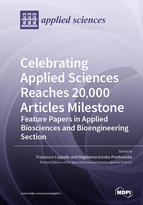Celebrating Applied Sciences Reaches 20,000 Articles Milestone: Feature Papers in Applied Biosciences and Bioengineering Section
A special issue of Applied Sciences (ISSN 2076-3417). This special issue belongs to the section "Applied Biosciences and Bioengineering".
Deadline for manuscript submissions: closed (20 January 2022) | Viewed by 42692
Special Issue Editors
Interests: cell differentiation; tissue homeostasis; organ remodeling; cell stress; chaperones; heat shock proteins; chaperonopathies; exosomes
Special Issues, Collections and Topics in MDPI journals
2. Euro-Mediterranean Institute of Science and Technology, 90139 Palermo, Italy
3. Department of Biophysics, Institute of Biomaterials and Biomolecular Systems, University of Stuttgart, 70174 Stuttgart, Germany
Interests: cancer; neurodegenerations; nitro-oxidative stress; molecular chaperones; metabolic reprogramming
Special Issues, Collections and Topics in MDPI journals
Special Issue Information
Dear Colleagues,
To celebrate the publication of 20,000 articles in Applied Sciences, we have taken the initiative to launch a Special Issue called “Celebrating Applied Sciences Reaches 20,000 Articles Milestone: Feature Papers in Applied Biosciences and Bioengineering Section”. We would like to invite well-known experts in all the areas of interest covered by “Applied Biosciences and Bioengineering” to submit their original research or review articles of the highest quality to celebrate with our readers on this special occasion.
This Special Issue intends to collect papers featuring important and recent developments or achievements in biosciences and bioengineering, with a special emphasis on recently discovered techniques or applications. The papers can cover either experimental or theoretical aspects or both, including the following topics: advanced diagnostics, anatomy and histology, biochemistry, bioinformatics, biomaterials, biomechanics, biomedicine, biotechnology, clinical engineering, drug delivery, genetics, immunology and microbiology, life science, neuroscience, oncobiology, physiology, radiology, tissue engineering, etc. Both research articles and review papers are welcome.
Prof. Dr. Francesco Cappello
Dr. Magdalena Gorska-Ponikowska
Guest Editors
Manuscript Submission Information
Manuscripts should be submitted online at www.mdpi.com by registering and logging in to this website. Once you are registered, click here to go to the submission form. Manuscripts can be submitted until the deadline. All submissions that pass pre-check are peer-reviewed. Accepted papers will be published continuously in the journal (as soon as accepted) and will be listed together on the special issue website. Research articles, review articles as well as short communications are invited. For planned papers, a title and short abstract (about 100 words) can be sent to the Editorial Office for announcement on this website.
Submitted manuscripts should not have been published previously, nor be under consideration for publication elsewhere (except conference proceedings papers). All manuscripts are thoroughly refereed through a single-blind peer-review process. A guide for authors and other relevant information for submission of manuscripts is available on the Instructions for Authors page. Applied Sciences is an international peer-reviewed open access semimonthly journal published by MDPI.
Please visit the Instructions for Authors page before submitting a manuscript. The Article Processing Charge (APC) for publication in this open access journal is 2400 CHF (Swiss Francs). Submitted papers should be well formatted and use good English. Authors may use MDPI's English editing service prior to publication or during author revisions.







